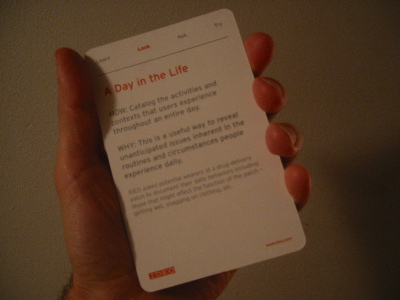Andrew Dillon’s work on digital genres, the web, and the shape of information is some of the most exciting research I’ve come across in the field of navigation. He has investigated how we can use our familiarity with genres to navigate, how navigation of information is different than navigation in physical space, and that creating navigation is essentially about creating meaning, not just road signs. And he manages to do this while retaining essentially a top-down perspective, not succumbing to a focus on merely organizing content. He doesn’t go as far as addressing larger user experience issues head on, but he positions his work in a way that acknowledges those issues.
If you have access to JASIS past issues, a good starting point is Spatial-Semantics: How Users Derive Shape from Information Space (JASIS. 51(6):521528, 2000). Otherwise download “It’s the journey and the destination” (PDF) where he questions the difference between navigation and content… ‘while physical navigation might be neatly divorced from the purpose of the journey, interactions with digital documents are not so easily divided. The purpose of moving though the information space is frequently the same purpose as the journey, to reach an end point of comprehension – and in this case the journey is the destination.’
Here’s my short form raw notes, which aren’t necessarily helpful to anyone else until I do something with them…
- Don’t misapply navigation from the physical domain to the semantic domain
- User’s perceive “global” schemata (generally how sites work) and “instantiated” schemata (how this particular site works). This can be apply to ideas of design conventions.
- The structure of a genre – the shape – is a global schemata. Users can predict ordering and grouping of elements. They know where a typical element belongs in the overall structure.
- Examples of genres online might be articles, blog postings, email headers…
- Need to leverage existing shape, and fit information into existing genres when possible.
- Cites research (Snowberry et al) that menu navigation has (basically) bad scent. So these ideas are helpful when categories don’t work due to unfamiliarity with the domain.
- Recognition of genre depends on experience and expertise of that genre. Integrate these attributes into user models.
- Upon entering a new location, users will identify unique spatial configurations (Siegal and White, Mandles). Immediately after, semantic processing begins.
- Shape is a property conveyed both by physical form and by information cotent
- “Technology is more malleable that the user” – Amen!
- Contrast expertise with differences in cognition (spatial ability or memory span). Also needs to be integrated into user models.
- Disorientation occurs when short term memory (STM) is overloaded (by lack of good navigation)
- Genre could be based on how a community uses information and varies by culture. Another attribute for user model.
